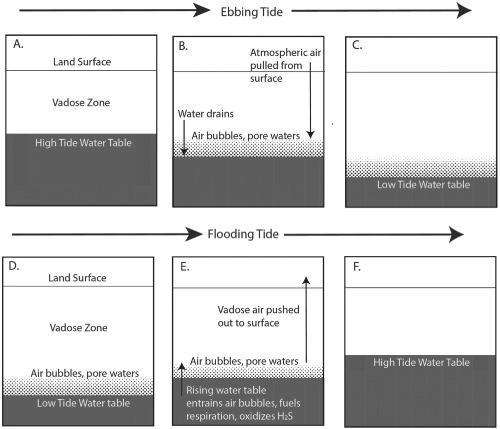当前位置:
X-MOL 学术
›
Earth Surf.Process. Land.
›
论文详情
Our official English website, www.x-mol.net, welcomes your feedback! (Note: you will need to create a separate account there.)
Tidal pumping and biogeochemical processes: Dissolution within the tidal capillary fringe of eogenetic coastal carbonates
Earth Surface Processes and Landforms ( IF 3.3 ) Pub Date : 2020-07-04 , DOI: 10.1002/esp.4922 J.D. Gulley 1 , D. Breecker 2 , M. Covington 3 , S. Cooperdock 2 , J. Banner 2 , P.J. Moore 4 , A. Noronha 2 , C. Breithaupt 1 , J.B. Martin 5 , J. Jenson 6
Earth Surface Processes and Landforms ( IF 3.3 ) Pub Date : 2020-07-04 , DOI: 10.1002/esp.4922 J.D. Gulley 1 , D. Breecker 2 , M. Covington 3 , S. Cooperdock 2 , J. Banner 2 , P.J. Moore 4 , A. Noronha 2 , C. Breithaupt 1 , J.B. Martin 5 , J. Jenson 6
Affiliation

|
Growing evidence suggests microbial respiration of dissolved organic carbon (DOC) may be a principal driver of subsurface dissolution and cave formation in eogenetic carbonate rock. Analyses of samples of vadose zone gasses, and geochemical and hydrological data collected from shallow, uncased wells on San Salvador Island, Bahamas, suggest tidally varying water tables may help fuel microbial respiration and dissolution through oxygenation. Respiration of soil organic carbon transported to water tables generates dysaerobic to anaerobic groundwater, limiting aerobic microbial processes. Positive correlations of carbon dioxide (CO2), radon‐222 (222Rn) and water table elevation indicate, however, that tidal pumping of water tables pulls atmospheric air that is rich in oxygen, and low in CO2 and 222Rn, into contact with the tidal capillary fringe during falling tides. Ratios of CO2 and O2 in vadose gas relative to the atmosphere indicate this atmospheric oxygen fuels respiration within newly‐exposed, wetted bedrock. Deficits of expected CO2 relative to O2 concentrations indicate some respired CO2 is likely removed by carbonate mineral dissolution. Tidal pumping also appears capable of transferring oxygen to the freshwater lens, where it could also contribute to respiration and dissolution; dissolved oxygen concentrations at the water table are at least 5% saturated and decline to anaerobic conditions 1–2 m below. Our results demonstrate how tidal pumping of air to vadose zones can drive mineral dissolution reactions that are focused near water tables and may contribute to the formation of laterally continuous vuggy horizons and potentially caves. © 2020 John Wiley & Sons, Ltd.
中文翻译:

潮汐泵送和生物地球化学过程:溶蚀成因海岸碳酸盐岩的潮汐毛细带
越来越多的证据表明,溶解的有机碳(DOC)的微生物呼吸作用可能是成因碳酸盐岩中地下溶解和溶洞形成的主要驱动力。对渗流带气体样本的分析以及从巴哈马圣萨尔瓦多岛浅层无套管井收集的地球化学和水文数据表明,潮汐变化的地下水位可能有助于通过充氧促进微生物的呼吸和溶解。运到地下水位的土壤有机碳的呼吸作用会产生从厌氧到厌氧的地下水,从而限制了需氧微生物的过程。二氧化碳(CO 2)的正相关,ra 222(222Rn)和地下水位标高表明,然而,在抽潮时,抽潮地下水位会使富含氧气,CO 2和222 Rn低的大气空气与潮汐毛细管边缘接触。渗流气体中CO 2和O 2相对于大气的比率表明,这种大气中的氧气促进了新暴露的湿基岩中的呼吸作用。相对于O 2浓度,预期CO 2的亏空表明一些呼吸的CO 2可能是由于碳酸盐矿物溶解而去除的。抽潮似乎也能够将氧气转移至淡水晶状体,在那里也可能有助于呼吸和溶解。地下水位的溶解氧浓度至少饱和5%,并降至低于1-2 m的厌氧条件。我们的研究结果表明,潮气向渗流带的泵送如何驱动矿物质溶解反应,使矿物质溶解反应集中在地下水位附近,并可能有助于形成横向连续的松散层位和潜在的洞穴。分级为4 +©2020 John Wiley&Sons,Ltd.
更新日期:2020-07-04
中文翻译:

潮汐泵送和生物地球化学过程:溶蚀成因海岸碳酸盐岩的潮汐毛细带
越来越多的证据表明,溶解的有机碳(DOC)的微生物呼吸作用可能是成因碳酸盐岩中地下溶解和溶洞形成的主要驱动力。对渗流带气体样本的分析以及从巴哈马圣萨尔瓦多岛浅层无套管井收集的地球化学和水文数据表明,潮汐变化的地下水位可能有助于通过充氧促进微生物的呼吸和溶解。运到地下水位的土壤有机碳的呼吸作用会产生从厌氧到厌氧的地下水,从而限制了需氧微生物的过程。二氧化碳(CO 2)的正相关,ra 222(222Rn)和地下水位标高表明,然而,在抽潮时,抽潮地下水位会使富含氧气,CO 2和222 Rn低的大气空气与潮汐毛细管边缘接触。渗流气体中CO 2和O 2相对于大气的比率表明,这种大气中的氧气促进了新暴露的湿基岩中的呼吸作用。相对于O 2浓度,预期CO 2的亏空表明一些呼吸的CO 2可能是由于碳酸盐矿物溶解而去除的。抽潮似乎也能够将氧气转移至淡水晶状体,在那里也可能有助于呼吸和溶解。地下水位的溶解氧浓度至少饱和5%,并降至低于1-2 m的厌氧条件。我们的研究结果表明,潮气向渗流带的泵送如何驱动矿物质溶解反应,使矿物质溶解反应集中在地下水位附近,并可能有助于形成横向连续的松散层位和潜在的洞穴。分级为4 +©2020 John Wiley&Sons,Ltd.



























 京公网安备 11010802027423号
京公网安备 11010802027423号